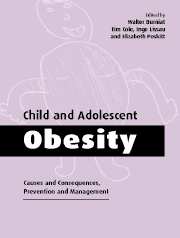Book contents
- Frontmatter
- Contents
- List of contributors
- Foreword
- Preface
- Part I Causes
- Part II Consequences
- 7 Clinical features, adverse effects and outcome
- 8 The obese adolescent
- 9 Prader–Willi and other syndromes
- 10 Hormonal and metabolic changes
- 11 Risk of cardiovascular complications
- Part III Prevention and management
- Index
7 - Clinical features, adverse effects and outcome
Published online by Cambridge University Press: 02 November 2009
- Frontmatter
- Contents
- List of contributors
- Foreword
- Preface
- Part I Causes
- Part II Consequences
- 7 Clinical features, adverse effects and outcome
- 8 The obese adolescent
- 9 Prader–Willi and other syndromes
- 10 Hormonal and metabolic changes
- 11 Risk of cardiovascular complications
- Part III Prevention and management
- Index
Summary
Clinical findings and immediate adverse effects
Obesity is one of the few conditions often diagnosed as easily by the layperson – even from a distance – as by the clinician. However, distinguishing normal fatness from abnormal fatness can be extremely difficult. This has been discussed in earlier chapters. Once obesity has been diagnosed, it is important to recognize the small proportion of obese children who have specific syndromes or pathology underlying their obesity. The vast majority of obese children remain those whose obesity does not seem associated with any underlying medical cause: simple, exogenous or nonpathological obesity. It is important to distinguish the obese children with underlying clinical disease or syndrome, but children with simple obesity also have specific problems and clinical signs. Tables 7.1 and 7.2 list the particular points to elicit in the clinical history and in clinical examination of children with simple obesity. Assessment is not easy. Too often, the subjective assumption – not totally unjustified – is that any symptomatology in these children must be secondary to their overweight and can therefore be cured by weight reduction alone. Further, the examination of grossly obese children, even when they are happy to be examined thoroughly, which is not always the case, is clinically difficult. Signs have to be elicited through the mass of fat. Equipment such as sphygmomanometers are not designed for use with the grossly obese. Thus, important symptoms and signs can easily be missed or ignored.
- Type
- Chapter
- Information
- Child and Adolescent ObesityCauses and Consequences, Prevention and Management, pp. 131 - 153Publisher: Cambridge University PressPrint publication year: 2002
- 4
- Cited by



